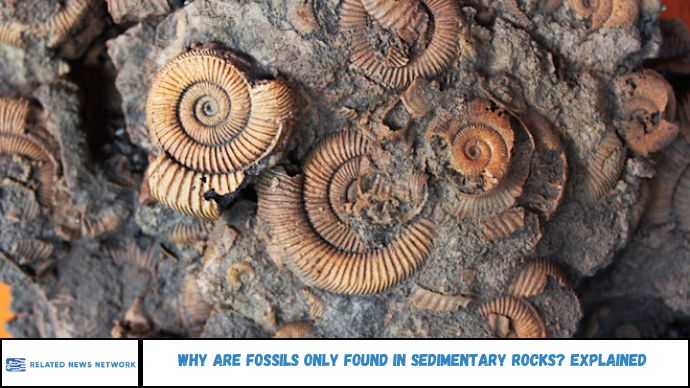“Fossils are the key to unlocking Earth’s deep past.” But have you ever wondered why fossils are only found in sedimentary rocks, and never in igneous or metamorphic ones?
It’s a common question among students, geology enthusiasts, and dinosaur fans alike. After all, fossils—remains of ancient life—are vital to understanding how life evolved. This article will explore why sedimentary rocks are uniquely suited for preserving fossils, how the process works, and what it tells us about Earth’s history.
The key to a successful fossil hunt lies in choosing the right location—and it’s no accident. Paleontologists don’t just dig anywhere; they carefully assess potential sites by considering the age of the rocks, their exposure at the surface, and, most importantly, the type of rock present.
Time and again, their search leads them to sedimentary rocks, not igneous or metamorphic ones. But why is that?
The answer lies in how each rock type forms. Sedimentary rocks are created in low-energy environments ideal for preserving ancient life, while igneous and metamorphic rocks are shaped by heat and pressure—forces that tend to destroy organic remains rather than protect them.
If you’re wondering how rock formation connects to fossilization, here’s what you need to know about the geological processes that make fossils possible—and the conditions that erase them.
Abstract
Fossils form exclusively in sedimentary rocks because these rocks are created through the slow accumulation of particles that gently bury and preserve organic material. Unlike igneous or metamorphic rocks, which involve extreme heat and pressure, sedimentary rocks offer the ideal environment for fossilization. This article explains the science behind fossil preservation, the different types of sedimentary rocks, and why they are central to paleontology.
What Are Sedimentary Rocks?
Sedimentary rocks are formed through the accumulation and compaction of mineral and organic particles, often carried by wind, water, or ice. Over time, these particles settle in layers, harden, and become solid rock.
Common Types of Sedimentary Rocks:
- Limestone – often contains marine fossils
- Sandstone – formed from compacted sand
- Shale – formed from clay and silt, rich in fossil finds
Why Fossils Form in Sedimentary Rocks
Fossils require specific conditions to form—conditions that sedimentary environments uniquely provide.
1. Gentle Burial Process
- Sediment slowly covers dead plants or animals, protecting remains from decay and scavengers.
- Over time, pressure compacts the sediment, preserving bones, shells, or imprints.
2. Lack of Heat and Pressure
- Fossils would be destroyed in the extreme heat of igneous rock formation (like lava flows).
- Similarly, metamorphic rocks undergo intense pressure and heat that distort or obliterate any preserved remains.
Fact: Fossils cannot survive temperatures above 200°C (392°F)—common in metamorphic and igneous processes.
3. Sediment Composition Supports Fossilization
- Many sedimentary rocks are rich in minerals like calcium carbonate, which help preserve hard tissues such as bones and shells.
How Fossils Are Preserved
There are several types of fossilization, but all require stable, low-energy environments—just like those where sedimentary rocks form.
Types of Fossil Preservation:
- Permineralization – minerals fill in pores of bone or wood
- Carbonization – organic material is reduced to a thin carbon film
- Impressions and Casts – shells or bodies leave imprints in soft sediment
Why Igneous and Metamorphic Rocks Don’t Contain Fossils
Igneous Rocks:
- Formed from molten magma or lava
- Temperatures are too high—any organic material is incinerated
Metamorphic Rocks:
- Created by transforming existing rocks through intense heat and pressure
- Fossils that may have once existed in these rocks are destroyed or deformed
Examples of Fossil-Rich Sedimentary Formations
- Burgess Shale (Canada) – Famous for soft-bodied marine fossils
- Morrison Formation (USA) – Rich source of Jurassic dinosaur bones
- Solnhofen Limestone (Germany) – Preserved the iconic Archaeopteryx
These formations help scientists study the evolution of life, extinction events, and ancient ecosystems.
FAQ
1. Why are fossils mostly found in sedimentary rocks?
Because sedimentary rocks form in gentle, low-heat environments where organic remains can be buried and preserved.
2. Can fossils be found in igneous or metamorphic rocks?
Very rarely. The high heat and pressure of these rock types destroy organic material.
3. What types of sedimentary rocks contain fossils?
Common fossil-bearing rocks include limestone, shale, and sandstone.
4. How do fossils form in sedimentary rocks?
Organisms are buried in sediments, then mineral-rich water preserves their remains as the sediment turns to stone.
5. Are all sedimentary rocks fossil-rich?
Not all. Fossils form only under the right conditions, such as quick burial and low oxygen levels to prevent decay.
6. Why is this important to science?
Fossils give us clues about ancient life, helping paleontologists trace evolution, extinction, and environmental change.
Conclusion
Fossils are a window into Earth’s deep past, and sedimentary rocks are the perfect preservers of that ancient story. Their unique formation process—slow, stable, and mineral-rich—makes them ideal for fossilization, unlike the destructive nature of igneous and metamorphic rocks.
Understanding why fossils are found only in sedimentary rocks not only helps us locate new discoveries, but also deepens our appreciation for the forces that preserve life’s most enduring records.







